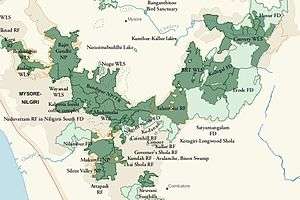Wayanad Wildlife Sanctuary
Wayanad Wildlife Sanctuary is an animal sanctuary in Wayanad, Kerala, India. It has an extent of 344.44 km2 with four ranges namely Sulthan Bathery, Muthanga, Kurichiat and Tholpetty. A variety of large wild animals such as Indian bison, elephant, deer and tiger are found there. There are also quite a few unusual birds in the sanctuary. In particular, peafowl tend to be very common in the area. Wayanad Wildlife Sanctuary is the second largest wildlife sanctuary in Kerala. It is bestowed with lush green forests and rich wildlife.This wildlife area houses some of the rare and endangered species of both flora and fauna.
| Wayanad Wildlife Sanctuary | |
|---|---|
 An Indian tiger in the Sanctuary | |
| Location | Wayanad, Kerala, India |
| Nearest town | Sultan Battery, Mananthavady |
| Coordinates | 11.646°N 76.364°E[1] |
| Area | 344 km2 (133 sq mi) |
| Established | 1973 |
Established in 1973, the sanctuary is now an integral part of the Nilgiri Biosphere Reserve. It is bounded by protected area network of Nagarhole and Bandipur of Karnataka in the northeast, and on the southeast by Mudumalai of Tamil Nadu.
It is part of the Deccan Plateau and the vegetation is predominantly of the south Indian moist deciduous teak forests. Also, the sanctuary has pastures of the west-coast semi-evergreen trees. The wildlife sanctuary comes under Protect Elephant and one can spot herd of elephants roaming in the area. Elephant rides are arranged by the Kerala Forest Department.
Wayanad district has the largest population of Adivasi in Kerala. Scheduled tribes here include Paniyas, Kurumas, Adiyans, Kurichiyas, Ooralis and Kattunaikkans. Comprising an area of 2126 km2, Wayanad has a powerful history. Relicts and edicts found in various parts of Wayanad speak of an important prehistoric era. Historians are of the view that organised human life existed in these parts, at least ten centuries before Christ.
The sanctuary is part of the Nilgiri Biosphere Reserve. The Western Ghats, Nilgiri Sub-Cluster (6,000+ km²), including all of the sanctuary, is under consideration by the World Heritage Committee for selection as a World Heritage Site.[3]
A monitoring programme of the Forest Department for 2017-18 has found that the Wayanad Wildlife Sanctuary (WWS), holds the largest tiger population in the State. Of the total 176 tigers in the State, 75 were identified from the WWS, which is part of a large forest complex holding the single largest population of tigers in India.[4]
History

Wayanad Wildlife Sanctuary was formed in 1973 and was brought under the Project Elephant in 1991–92. This sanctuary occupies an area of 345 km2. It is the second largest one in the state of Kerala. The sanctuary is separated into two disconnected parts known as the North Wayanad Wildlife Sanctuary and South Wayanad Wildlife Sanctuary. The area in between the two parts was originally a forest region, though it is now occupied majorly by plantations.
In 2012, a tiger was shot dead by the Kerala Forest Department on a coffee plantation on the fringes of the Wayanad Wildlife Sanctuary. Many local political leaders applauded the killing of the tiger. Chief Wildlife Warden of Kerala ordered the hunt for the animal after mass protests erupted as the tiger had been carrying away domestic animals.
Flora and fauna
Flora: Moist deciduous forest consists of maruthi, karimaruthi, rosewood, venteak, vengal, chadachi, mazhukanjiram, bamboos, more, while the semi-evergreen patches comprises veteria indica., lagerstroemia, lanceolata, termianalia paniculata.
Fauna: Elephants, tigers, panthers, jungle cats, civet cats, monkeys, wild dogs, bisons, deer, bears, monitor lizards and a variety of snakes are seen.
Avian-Fauna: Peacocks, babblers, cuckoos, owls, woodpeckers, jungle fowls are a few of the various types of birds seen here.
Climate
Wayanad climate is salubrious. Average rain fall in this district is 2322 m.m. Annual rain fall in these high rain fall areas ranges from 3,000 to 4,000 mm. High velocity winds are common during the south west monsoon and dry winds blow in March–April. High altitude regions experience severe cold. This place experiences a high relative humidity which goes even up to 95 per cent during the south west monsoon period. Generally, the year is classified into four seasons, namely, cold weather, hot weather, south west monsoon and north east monsoon. The dale, 'Lakkidi', nestled among the hills of Vythiri taluk has the highest average rainfall in Kerala.
Location: The south Wayanad division is located 16 km east of Sulthan Bathery and north wayanad division 20 km from Mananthavady in the state of Kerala.
Visiting time: Everyday 7.00 am - 5.00 pm.
Threatened Status of Vultures
Wayanad Wildlife Sanctuary is one of the safest havens for different species of vultures like the White-rumped Vultures and the Red-headed Vultures. The collective population of these vultures numbered around 150 in February 2016 dropped to about 70 in March 2016. A survey last year counted as many as 17 vulture nests, however, this number reduced to about 11 vulture nests in March 2016. The banned drug Diclofenac is believed to be the reason for this fall in the vulture count.[5]
References
- "Wayanad Sanctuary". protectedplanet.net.
- "Wayanad Sanctuary". protectedplanet.net.
- UNESCO, World Heritage sites, Tentative lists, Western Ghats sub cluster, Niligiris. retrieved 20 April 2007 World Heritage sites, Tentative lists
- https://www.thehindu.com/news/national/kerala/wayanad-wildlife-sanctuary-is-tiger-kingdom-of-the-state/article27130761.ece
- "Vulture nests in WWS decline". The Hindu. 10 March 2016. ISSN 0971-751X. Retrieved 14 June 2016.
External links
| Wikimedia Commons has media related to Wayanad Wildlife Sanctuary. |
Reference Link : https://www.gotirupati.com/wayanad-wildlife-sanctuary